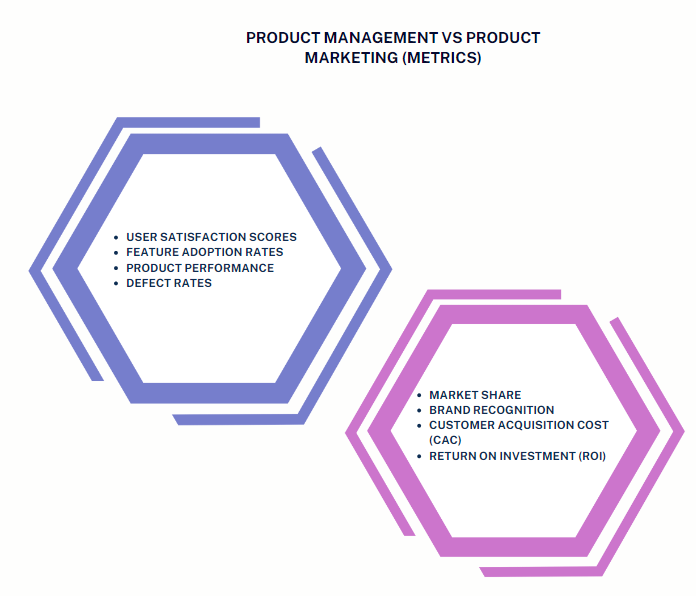For product-led companies, the roles of product marketing and product management are both crucial. Product managers lead the effort to build the right product, whereas product marketers ensure that the product reaches the right audience.

Although the focus of each role differs, the collaboration contributes to the same goal. This article analyzes the key differences between the two roles, the middle ground, and strategies for fostering effective teamwork.
Understanding the roles
Product management and product marketing both contribute to the success of a product in their own capacity. Product managers have distinct responsibilities and so do marketers. Product managers are primarily concerned with developing the product (product lifecycle) and they have to make sure it meets customer needs:

On the other hand, product marketers focus on correctly positioning the product in the market. They craft the right messaging and drive demand by using marketing strategies.
The collaboration between these functions results in cohesive product development and effective market entry, two defining factors for initial product success.
Key differences between product management and marketing
As a product manager, you build the product and review the metrics related to product engagement. The right product meets the customer’s needs and aligns with the company’s vision, and the metrics will reflect that as well.
Product marketing promotes the product. They have to make sure that the product reaches the target audience and stands out in the marketplace filled with competitors. The primary metrics of success align more with growth.
In a nutshell:
- Product management focuses on defining and developing the product
- Product marketing focuses on positioning and promoting the product
- Product management success is measured by product performance and customer satisfaction
- Product marketing success is measured by market share and revenue growth
Metrics for product management and marketing
Product management metrics focus on the product’s performance. They contain metrics related to usability and alignment with customer needs. In contrast, product marketing metrics are centered on market reception, brand awareness, and sales growth:

- Product management metrics refer to user satisfaction scores, feature adoption rates, product performance, and defect rates
- Product marketing metrics refer to market share, brand recognition, customer acquisition cost (CAC), and return on investment (ROI)
Critical points of collaboration between the roles
Product management and product marketing must work in close harmony throughout the product lifecycle. This becomes especially true when it comes to product positioning and messaging. Both roles should also share input when coordinating the timing and execution of product launches (go-to-market strategies).
Effective collaboration pushes both teams to deliver the product’s value to the target audience. Make sure to:
- Collaborate early on defining the product’s unique value proposition
- Ensure consistent messaging. Messaging should resonate with both users and the market
- Synchronize launch plans. It ensures product readiness aligns with marketing efforts
- Work together to refine go-to-market strategies. Modify based on customer feedback and market trends
Strategies for effective teamwork
You can help both teams stay on the same page with regular communication and joint objectives. Alignment slowly but surely paves the way for product success. Although both roles focus on different metrics, they still share enough to form critical discussion points between the two:

To maintain consistent communication:
- Hold weekly alignment meetings. Discuss product progress and marketing strategies
- Set joint goals. Reflect on both product development and market performance
- Use shared metrics to measure progress. It holds both teams accountable
- Maintain open communication channels. It will help quickly address any challenges or changes
Product success through collaboration
Notion experienced a quick rise in the productivity tools space. It originally launched as a note-taking app but over time the product evolved into a flexible workspace tool. What was the main catalyst for success? The marketing team provided powerful actionable insights about user trends and market space whereas the product team acted on it proactively.
In the early stages, the Notion product management team prioritized highly customizable features for teams. The main user base was relevant to project management and knowledge sharing. Upon research, the marketing team amplified this versatility by launching targeted campaigns that showcased Notion’s adaptability (particularly for remote teams). Additionally, they aligned the product’s messaging with the growing demand for remote work solutions. The cross-team collaboration proved to be instrumental in Notion’s rapid adoption and growth in the productivity market.
The following best practices can prove useful for your workflow as well:
- Align product features with emerging market trends and customer demands
- Collaborate on product messaging. Highlight its adaptability and scalability
- Use user feedback loops. This data helps you to refine both product features and marketing strategies
- Product updates and feature releases should be coordinated with marketing campaigns to maximize impact
Key takeaways
For a product to be successful, both roles have to contribute their valued perspectives and expertise. The joint efforts are part of every major product strategy and modification. For a product manager, the marketing team insights provide the best insights on what to build and how to correctly position it in the market.
For your daily reference, return to the following key points:
- Product management builds the product; marketing positions it
- Regular communication keeps teams aligned
- Shared goals create a focus for both teams
- Coordinate product launches for maximum impact
- Continuously adjust strategies based on performance
If you focus on these areas, you can successfully manage the product lifecycle. Once you complete the initial phase, the marketing insights will then help you keep the product on track for the long run.
Featured image source: IconScout